VIADUCT: a long high bridge, usually with arches, that carries a road or railway/railroad across a river or a valley (Oxford dictionary). We chose this name for our research symbolically, describing the need for a communication bridge between heritage professionals and scientists.
Within the context of improving the comprehension and interpretation of Built Heritage, the problem of the use of "different languages" between the various related professionals has sometimes led to inappropriate methodologies of study. This “Tower-of-Babel” is not only due to the use of a specific jargon by each expert, but also reveals the deeper problem of misunderstanding of each researcher’s questions and the difficulties and challenges of their professional context.
The present website is one of the outcomes of VIADUCT, a research whose main aim was the creation of comprehension tools for bridging communication gaps of different heritage professionals regarding heritage scientific analysis.
Targeting the research onto buildings conservation, our main objective was the categorization and explanation of the characterization analysis and of the dating methods, namely the methods related to the technological processes of fabrication of any construction. Of these two research method families, we will focus 21 investigation techniques related to building materials, namely stone, CBM (Ceramic Building Materials), mortar, wood, metal (iron and lead) and the pigments and most frequently used in the western world.
With the aim of creating a multi-perspective handbook and website useful for all, applying at the same time the concept of interaction in action, DIADRASIS formed a research team composed of four different professional profiles: an Archaeometrist, an Architect & Art Historian, a Chemist and a Conservator of Antiquities. These two are not meant to compete with the extended scientific literature on the subjects, but to become a tool for communication. The explanations have therefore been simplified, as requested by many professionals. In order to avoid any misinterpretation, a list of more detailed references is provided for users requiring further information at the end of each analysis.
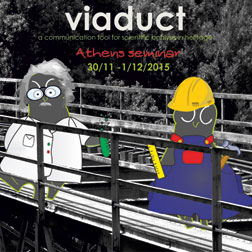
Viaduct seminar: do we make the best out of our analysis? Two days seminar for heritage specialists, 30/11 - 1/12/2015, Athens
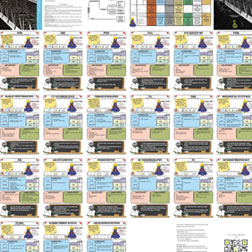
Foldable poster
availiable at diadrasis
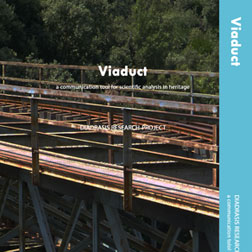
Book: Viaduct, a communication tool for scientific analysis in heritage. ISBN
978-618-81473-1-7
availiable at diadrasis
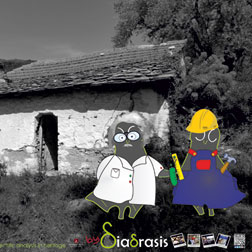
"Inspector Clouseau and the abandoned building" workshop for the wider audience @ 1st mediterranean science festival, 6/12/2015, Cyprus
Scientific analyses can become powerful tools for heritage professionals, when properly proposed and suitably conducted; which means using the appropriate method, within correct timing of the project. This necessitates not only appropriate and clear questions according to the objectives of the research and the conservation needs, but also a prior deep understanding of the site and its relation to different external parameters.
Following the anamnesis of the building we propose a checklist of distinctive questions the team of heritage professionals need to discuss and clarify with the scientists, in order to get the most out of their analysis:
The website summarizes the main results of the research that have been published in the book “Viaduct a communication tool for heritage analysis”, 2015 , Athens: Diadrasis
Science reflects continuous evolutions. Therefore, as we are dealing with scientific analy- sis, it is expected that what is innovative today can be easily substituted in a near fu- ture. The methods presented in this website are the ones more commonly used at the moment but some are already evolving. New scientific discoveries are continuously offering new tools to Archaeometry and, although the distant future might reserve extremely innovative options, current research focuses on improving already existing scientific methods. These improvements are mainly related to portability, non-invasive analysis and direct dating.

Archaeometrist, postdoctoral researcher at the FRS-F.N.R.S., University of Liège (Belgium).
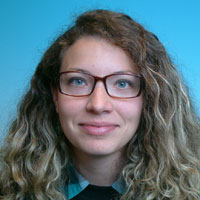
Conservation scientist, Nuclear Chemistry Unit, Institute for Transuranium Elements, Joint Research Centre-JRC of the European Commission

Architect & Art Historian, co-founder & Projects’ Director of DIADRASIS (Greece) and Deputy Director of Documentation and Communication (CNCPC-INAH)(Mexico).

Conservator of Antiquities, co-founder & Managing Director of DIADRASIS, (Greece).
Architectural conservation is always an expensive endeavour. This is due to two main parameters: the large scale of the object of study and the great variety and number of professions involved in every architectural conservation project. So don't forget: Preliminary studies have a strong positive impact on the budget, before any scientific analysis is decided. The observations of these studies will lead to the correct choice of scientific analyses to be integrated in a project, evaluating at the same time the indispensable data required, the accuracy of this data, the possibility of destruction of original materials and, certainly cost and time.
The viaduct on the cover spans the empty space between the Pelion Mountain valleys. It is there, in the picturesque village of Gatzea, that in 2013 DIADRASIS team developed a seminar on architectural stratigraphy (Gatzea II). Back then, Dr Sophie Blain, archaeometrist specialized on dating methods, was one of the participants. During the seminar we had long discussions and exchanged ideas and opinions about the complementarity of disciplines in conservation. The issue of the enormous gap of communication between science and heritage people kept coming up all the while. All these but mainly her excellent lecturing abilities led us to adding off-program an improvised and very inspiring presentation on dating methods. Interaction in action! All participants and the organizers agreed that when it comes to scientific analysis, most of us feel frustrated. This frustration derives from a problem of communication. We thought of searching for a way to bridge this gap by creating tools for communication through an active dialogue. A new research project was almost born!
A few months later, Ariadni Dimitrakopoulou, BA in Chemistry at the University of Patras, Greece, and Master's Degree in Conservation Science at the University of Bologna, Italy, with a thesis on Archaeometry, conducted at the University of Ghent, Belgium, contacted DIADRASIS to participate in our internship programme. Her profile was the exact missing link from our Gatzea “bridge” plans, so we were now ready to hit the road.
Still, great ideas have practical difficulties. The research required funding and the answer to that came following the open call for new scientists by the John S. Latsis Public Benefit Foundation. This would be our team’s first opening in such a competitive environment so, would we ourselves be able enough to communicate the necessity for this research? Apparently we were, and thanks to their generous support, VIADUCT grew from a vague idea into a true project. The outcome of this funding is not only this website a handbook, as well as a brief two-day seminar that will widen the dialogue opened with this project.
This project, coordinated by DIADRASIS, owes much to the institutions that trusted our idea and contributed greatly with their support:
in collaboration with the Coordinación Nacional de Conservación del
Patrimonio
Histórico (CNCPC) of the
Instituto
Nacional de Antropología e Historia (INAH), Mexico, the
FRS-F.N.R.S. and Université de Liège (ULg), Belgium.
This project would not have been possible without the support of different professionals around the world.